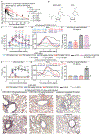Characterization of orally efficacious influenza drug with high resistance barrier in ferrets and human airway epithelia
- PMID: 31645453
- PMCID: PMC6848974
- DOI: 10.1126/scitranslmed.aax5866
Characterization of orally efficacious influenza drug with high resistance barrier in ferrets and human airway epithelia
Abstract
Influenza viruses constitute a major health threat and economic burden globally, frequently exacerbated by preexisting or rapidly emerging resistance to antiviral therapeutics. To address the unmet need of improved influenza therapy, we have created EIDD-2801, an isopropylester prodrug of the ribonucleoside analog N 4-hydroxycytidine (NHC, EIDD-1931) that has shown broad anti-influenza virus activity in cultured cells and mice. Pharmacokinetic profiling demonstrated that EIDD-2801 was orally bioavailable in ferrets and nonhuman primates. Therapeutic oral dosing of influenza virus-infected ferrets reduced group pandemic 1 and group 2 seasonal influenza A shed virus load by multiple orders of magnitude and alleviated fever, airway epithelium histopathology, and inflammation, whereas postexposure prophylactic dosing was sterilizing. Deep sequencing highlighted lethal viral mutagenesis as the underlying mechanism of activity and revealed a prohibitive barrier to the development of viral resistance. Inhibitory concentrations were low nanomolar against influenza A and B viruses in disease-relevant well-differentiated human air-liquid interface airway epithelia. Correlating antiviral efficacy and cytotoxicity thresholds with pharmacokinetic profiles in human airway epithelium models revealed a therapeutic window >1713 and established dosing parameters required for efficacious human therapy. These data recommend EIDD-2801 as a clinical candidate with high potential for monotherapy of seasonal and pandemic influenza virus infections. Our results inform EIDD-2801 clinical trial design and drug exposure targets.
Copyright © 2019 The Authors, some rights reserved; exclusive licensee American Association for the Advancement of Science. No claim to original U.S. Government Works.
Conflict of interest statement
Figures





References
-
- Palese P, Shaw ML, in Fields Virology, Knipe DM, Howley PM, Eds. (Wolters Kluwer/Lippincott Williams & Wilkins, Philadelphia, 2007), vol. 2, chap. 47, pp. 1647–1690.
-
- World Health Organization fact sheets influenza (seasonal) https://www.who.int/news-room/fact-sheets/detail/influenza-(seasonal). (2019).
-
- Garten R, Blanton L, Elal AIA, Alabi N, Barnes J, Biggerstaff M, Brammer L, Budd AP, Burns E, Cummings CN, Davis T, Garg S, Gubareva L, Jang Y, Kniss K, Kramer N, Lindstrom S, Mustaquim D, O’Halloran A, Sessions W, Taylor C, Xu X, Dugan VG, Fry AM, Wentworth DE, Katz J, Jernigan D, Update: Influenza Activity in the United States During the 2017-18 Season and Composition of the 2018-19 Influenza Vaccine. MMWR Morb Mortal Wkly Rep 67, 634–642 (2018). - PMC - PubMed
Publication types
MeSH terms
Substances
Grants and funding
LinkOut - more resources
Full Text Sources
Other Literature Sources
Medical

